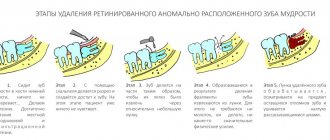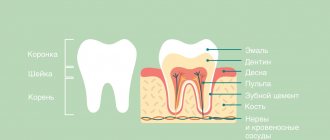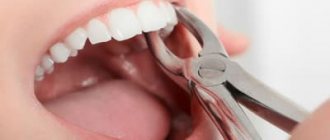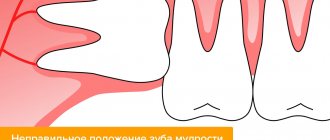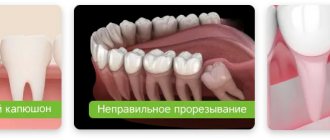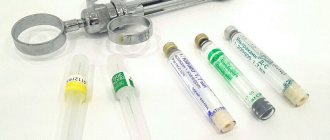Dear friends, last time we talked about what wisdom teeth are like, when they need to be removed and when not. And today I will tell you in detail and in every detail how the removal of “sentenced” teeth actually takes place. With pictures. Therefore, I recommend that especially impressionable people and pregnant women press the “Ctrl +” key combination. Joke.
Where does the removal of the 8th, and, in principle, any other tooth begin?
With anesthesia.
So:
Anesthesia (pain relief)
To minimize discomfort during an injection, you need to treat the injection site with a special anesthetic gel. This is the so-called topical anesthesia. It is very often used in pediatric dentistry, but we also use it in working with adults. As practice shows, there are fewer unpleasant sensations, and the taste is pleasant... at least some kind of joy.
When removing teeth from the upper jaw, as a rule, a simple infiltration of anesthetic into the area of the tooth being removed is sufficient. It is carried out using a special syringe with specially selected anesthetics and is called infiltration .
When removing teeth on the lower jaw, infiltration anesthesia is usually not enough (with the exception of the frontal group of teeth, from canine to canine). Therefore, the anesthesia technique changes somewhat - the anesthetic, using a long but very thin needle, is applied directly to the nerve bundle responsible for the innervation of the desired areas. This anesthesia allows you to “turn off” sensitivity not only in the area of the tooth being removed, but also in the lip, chin, part of the tongue, etc.
It should be noted that during and immediately after anesthesia, a number of interesting phenomena may be observed - increased heart rate, trembling of limbs, an inexplicable feeling of anxiety. Many patients begin to panic about this. But there is no need to panic! These are side effects of most modern anesthetics and go away on their own within 10-15 minutes.
Well, the anesthesia is done! Now you need to make sure that it was carried out successfully?
Those places that should ideally be numb are listed above. Also, using a special instrument and pressing on the gum in the area of the operated tooth, we determine whether the pain still remains or no longer exists. The only thing that should be felt is the sensation of “something” touching the gum. That is, tactile sensations are still preserved, but pain is no longer present.
And then our actions differ depending on what type of wisdom tooth we are dealing with.
What to do after deletion
After any surgical intervention, you should follow all the dentist’s recommendations, as well as:
- do not eat for 2 hours after the procedure;
- cool the soft tissues of the face in the projection of the removed root;
- stop smoking for two days;
- take prescribed pain medication;
- make antiseptic applications;
- watch to see if other teeth are crumbling.
Sometimes after complex extractions, dentists prescribe antibiotics to patients.
This appointment cannot be ignored - after a tooth is pulled out of the socket, a focus of infection forms in it, which can only be extinguished with the help of medications.
The following video schematically shows different methods for removing incisors, canines, molars and premolars of the lower and upper jaw.
Impacted wisdom tooth
These are usually the hardest eights to remove out of all the others. We have already numbed the surgical field. What's next?
It's under the gum! So, we take a scalpel in our hands and make a delicate incision in the area of the tooth being removed. This creates access to the wisdom tooth being removed. It is isolated from the surrounding tissues using special instruments, and now we can visually assess its position and choose a removal technique.
If the tooth does not erupt, it means that something is preventing it. This “something” will also interfere with its removal, and this “something” could be a neighboring tooth, a bony protrusion, etc. However, you won’t also remove the seven to get to the wisdom tooth, right?
Special surgical tip for removing wisdom teeth. Rotates at the right frequency, provides the right torque, does not burn tissue or inflate emphysema. In surgery, we use only such devices.
Therefore, we divide the tooth into parts. Using a special tip with a cutter speed of 150,000 rpm - this is no longer a simple angle cutter, but not yet a turbine cutter. The latter, by the way, is highly undesirable to use for removing teeth, because at 500,000 rpm it is easy to burn everything with a hellish flame, and with air from the cooling nozzle you can also inflate emphysema over half your face. In general, for removal you need to choose the right tools; there are no trifles or compromises here and cannot be. And you should think a hundred times before removing such problematic teeth in a one-chair dental office at a rural club on the “Half-Empty Bins” collective farm.
Impacted teeth are removed mainly with an elevator, and not with forceps, as many are accustomed to thinking
So, we divide the tooth into 2-3 parts in order to remove it carefully and with little trauma to the surrounding tissues. And teeth are usually removed using an “elevator” (in the picture on the left). Forceps, which everyone associates with removal, are actually used extremely rarely.
Well, the tooth has been removed. Next, we clean the tooth socket from “sawdust” and small tooth fragments that might remain. Using a curette.
When removing wisdom teeth, no biomaterials are used; the hole is filled with a blood clot on its own, this is quite enough for normal healing.
Moreover, “pushing” biomaterials into the hole can complicate the healing process, so let the regeneration process take place naturally and simply, and not fancy, as some doctors suggest.
After removal, resorbable (absorbable) sutures are placed on the hole; most often they do not need to be removed.
The clot is in place. Next, we bring the edges of the wound together and put stitches so that food doesn’t get stuck in the wound, it doesn’t bleed too much, and it heals faster. But at the same time, the sutures should not be tight, because the wound may bleed significantly during the first 24 hours. And if you don’t create an outflow, edema often develops.
Who will have to part with a tooth?
Complications following tooth extraction in the doctor's office are extremely rare. Much more often, sad consequences occur when it spontaneously falls out due to destruction or injury. In such cases, there are two options: restoration of dentin and enamel or removal of the tooth root.
The tooth root will have to be removed if the following symptoms occur:
- constant discomfort in the gums;
- sharp pain when chewing;
- swollen soft tissue;
- bleeding;
- the appearance of pus.
A sure sign of an inflammatory process in the gums is an increase in body temperature in the absence of symptoms of another disease.
Important! You cannot postpone a visit to the dentist, even if only one of these symptoms appears. Any suspicion that the tooth root remains in the gum and has begun to rot should prompt an urgent visit to a doctor.
What are the roots of teeth, look at the photo:
Temporary contraindications
Surgical removal of the root of a decayed tooth is contraindicated during:
- relapse of complex mental disorder;
- acute phase of ARVI;
- exacerbation of neurological disease;
- rehabilitation after a heart attack.
Doctors at dental clinics are aware of all contraindications to extraction. But not all conditions have clear clinical signs, so in order to avoid unpleasant consequences, it is necessary to warn the doctor about the ailment.
Semi-retinated tooth
In principle, the method of removing such a tooth is no different from removing a completely impacted tooth. But, as a rule, it is a little easier, because the tooth is not so deep. The main stages are essentially the same: anesthesia, creating access to the tooth (and sometimes you can do without incisions), fragmentation (dividing the tooth into parts) and, in fact, removing the teeth in parts.
After removing the lower semi-impacted tooth, sutures are placed on the socket; in the area of the upper wisdom teeth, sutures are not necessary.
When is complex tooth extraction indicated?
Tooth extraction is considered difficult due to tumor or edema, periodontitis, periodontitis, abscess and gumboil. The presence of a cyst and a fistulous tract in the tooth also complicates the removal procedure. Impacted (unerupted) teeth are also indications for surgical tooth extraction. Complex cases include the removal of a dystopic wisdom tooth located outside the dentition; removal of 4 teeth to correct malocclusion; removal of baby teeth in children at an early age. Severe curvature of the roots and fracture of the apical part of the root are also indications for surgery. Please note that complex tooth extraction is not performed during pregnancy.
The method in which your tooth will be removed depends on the individual case. Only a specialist can determine the removal strategy. In any case, you should not be afraid of this procedure. A competent doctor will perform the removal correctly, and all you have to do is say “thank you”
Dystopic tooth
Removing such teeth can be called a simpler case compared to others, but only if the tooth has one straight root. Then the removal can take place quite quickly. But such clinical cases are extremely rare. And, looking at the picture, we see hooks, not roots, which, with proper pressure, can simply break. There are usually 2 roots, and in this case we just need to separate one root from the other using the same tool - the “raising” tip. And carefully remove each of the roots separately. The beginning and completion of the removal of such teeth is the same as for all others.
Forceps
This is the main device that helps pull the tooth out of the socket. The doctor literally grabs the tooth with forceps and begins to swing it, which leads to the destruction of the ligaments holding the root. Next, the dentist carefully removes the tooth along with the root, again using forceps. The device looks, of course, scary, but not a single dental surgeon can do without forceps. It is noteworthy that such a seemingly simple tool is available in many variations: with inclined, thick or thin, with rounded or even flat nippers (or, in scientific terms, cheeks).
Dental forceps
And it also happens...
... that wisdom teeth block the neighboring teeth and prevent them from erupting normally. In such cases, patients are referred to a surgeon by an orthodontist.
Of course, the germ of the eighth tooth needs to be removed. This is a fairly simple and relatively comfortable operation.
Look at the pictures on the right. There is a difference of three weeks between the top and bottom. It is clearly visible from them that after removing the rudiments of the eights and “unblocking”, the seventh teeth immediately began to grow.
Wisdom tooth removed. The patient is satisfied. But the fun is yet to come. Namely, the postoperative period.
How to remove a rotten tooth root while preserving the crown
A tooth in which only the root remains is not always pulled out entirely. For example, if an inflammatory process develops at the root apex, but the tooth itself can still be saved, resection of the root apex is performed - partial removal.
The procedure is carried out after filling the canals, under local anesthesia. The operation is simple and lasts no more than half an hour. Its main stages:
- Anamnesis collection.
- Preparation of the surgical field.
- Anesthesia.
- Cutting the gum to access the root.
- Delamination of soft tissues.
- Sawing out a “window” in the bone.
- Cutting off the inflamed area of the root with a granuloma or cyst.
- Placing drugs into the cavity that stimulate bone growth.
- Stitching.
